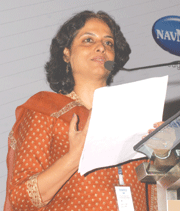 There are numerous excellent pre-school programmes for the affluent, concentrated in urban India. Unfortunately, over 90 percent of the country’s socio-economically under-privileged children are unable to access pre-school education. This majority includes children with disability. In recent times considerable research data has emerged which reinforces the theory that the most cognitively formative or critical years of every child are before she enters formal school. A stimulating early childhood education and caring environment gives a head start to all children, including children with disability. In fact the consequences of inadequate stimulation in early age are more disastrous for children with disability. Children who are socio-economically disadvantaged or disabled are at greater risk of suffering scholastically, linguistically and educationally.
There are numerous excellent pre-school programmes for the affluent, concentrated in urban India. Unfortunately, over 90 percent of the country’s socio-economically under-privileged children are unable to access pre-school education. This majority includes children with disability. In recent times considerable research data has emerged which reinforces the theory that the most cognitively formative or critical years of every child are before she enters formal school. A stimulating early childhood education and caring environment gives a head start to all children, including children with disability. In fact the consequences of inadequate stimulation in early age are more disastrous for children with disability. Children who are socio-economically disadvantaged or disabled are at greater risk of suffering scholastically, linguistically and educationally.
The focus of this presentation is an inclusive pre-school programme introduced for the Union govern-ment’s Integrated Child Development Scheme (ICDS). This programme is based upon the doctoral research of Dr. Mithu Alur, founder chairperson, ADAPT (formerly The Spastics Society of India), on developing an enabling policy for the disabled in India with particular focus on ICDS which covers pre-school children in the age group 0-6 years from socio-economically disadvantaged groups.
Dr. Alur’s research indicates that ICDS services are not extended to children with disability who are routinely turned away. To examine whether children with disability benefit from inclusive early childhood education, ADAPT began a two-year research project in collaboration with Unicef titled Inclusive Education Practice in Early Childhood in Mumbai. The research was conducted in Dharavi, Asia’s largest slum, focusing on families living in deep poverty and covered children who were disabled and non-disabled and excluded from the mainstream educational system.
The prime objective of this study was to formulate intervention strategies needed to induct children with disabilities into existing government programmes so that inclusive education could happen within their framework. We looked at the tools needed to identify children with disabilities; simple modifications within classrooms to ensure all children’s participation; capacity building required for teachers to be able to deal with differences, and sensitisation programmes to promote the community’s acceptance of children and families with disabled children.
There were two key components of the project: research and intervention. We worked with 6,000 households and 600 children and established inclusive anganwadis (child care centres) to demonstrate inclusion. We included not just children with disability but also the girl child and socio-economically disadvantaged children.
Training and empowerment of teachers was a critical component of our inclusion programme. A training programme was designed to equip women from the local community to become anganwadi multipurpose workers (AMWs).
For the programme to succeed, it was important to learn about the children’s local environment. Dr. Alur and her team conducted an ecological survey of the area. This gave us the knowledge we needed about the environment and the routine and recreational activities of children.
Since this was a research study, external research consultants also conducted three surveys: baseline, mid term and end term. Two new scales were developed to measure progress: Development Scores and Barriers to Inclusion.
In the inclusive anganwadis we found an increase in develop-ment scores of children with disability across all parameters — social, emotional, communication, creativity, motor and functional skills. A decrease in the barriers to inclusion was found in varying degrees in the physical space, behaviour of AMWs, attitude of parents and classroom activities.
At the end of the project period, all children were admitted into local mainstream schools. From this research emerged a series of instructional resource material: ‘How to Series of Inclusive Education’. These manuals are relevant for any organisation, or agency working to address the crucial need of bringing children with disability into inclusive settings.
Our argument is that if positive inclusion could be demonstrated in an impoverished area such as Dharavi, it can happen anywhere. If community workers with minimal training can address children with disability, why can’t we include children with disability into all learning programmes? Why can’t all pre-school programmes be inclusive? Inclusive education is merely good education; it looks at the attributes and needs of each child, which is what all good pre-school programmes should do.
Let us collaborate to build an inclusive society, beginning with the early years.
(Varsha Hooja is a trustee and director at the Spastics Society of India, now called ADAPT (Able Disabled All People Together) and has been working in the area of disability and inclusion for over 25 years)